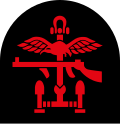| 2nd Special Service 2nd Commando Brigade | |
|---|---|
| Active | 1943–1946 |
| Allegiance | |
| Branch | |
| Type | Commando |
| Role | Coastal raiding Assault infantry Special operations |
| Part of | Combined Operations |
| Engagements | Second World War |
| Commanders | |
| Notable commanders | Ronnie Tod |
| Insignia | |
| Combined Operations Tactical recognition flash |  |
The 2nd Special Service Brigade was formed in late 1943 in the Middle East and saw service in Italy, the Adriatic, the landings at Anzio and took part in operations in Yugoslavia. [1] On 6 December 1944 the Brigade was renamed 2nd Commando Brigade, removing the title Special Service and its association with the Schutzstaffel. [2]